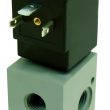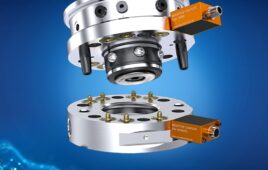Proportional valves are considered both flow and directional valves, to meter flow and control the direction in which flow is metered. When specifying a proportional valve for fluid power control, you need a driver to control the ramp rate and open the valve. Combining these two devices together allows you to have control flow precisely, but adding the driver can sometimes cause efficiency losses.
Spartan Scientific saw a need to create one integrated device, which is more programmable and more controllable than what exists in the market with the individual valve and driver combo. Its Stepper 12 is a self-contained media separated electronic proportional flow control valve. Using different positions (or steps), these valves can precisely regulate flow output and require minimal power to maintain a desired position, maximizing energy savings.
Applications only limited by imagination
The Stepper 12 provides highly accurate electronic variable flow control of inert fluids and gases. The combination stepper motor and valve body with controller circuit accommodates more than 1,500 valve stroke positions, allowing for use in countless designs.

Industries that can benefit from the Stepper 12 proportional valve include food and drug, automobile, truck and bus, agriculture, fluid temperature control, and beyond.
“Nothing existed like this in the market. We wanted to make one integrated package, which does everything,” said Josh Blackann, Hardware Engineer with Spartan Scientific. “We’re not just saying, ‘Well, this is it, and this is the only option that’s available.” We want to work with customers to find out, ‘What is it you’re trying to do? Let’s see if we can get the Stepper valve that will accomplish the task that you are trying to do.’ We’re in the business of trying to make these for our customers if they want something special.”
Common applications include heating and cooling, proportional gas control, car wash proportioning, HVAC, process control, automation, bioprocess equipment, machining coolant, bioremediation, cleaning technologies, agricultural implements, food processing, fertilizer equipment, invitro diagnostics, lab test equipment, liquid material handling, lubrication, marine equipment, medical devices, automated milking, misting systems, packing equipment, process cooling, robotics, dosing equipment, water chillers, RO systems, water treatment, fluid dispensing equipment, and more.
For example, when a commercial fire truck manufacturer wanted to modernize its foam compression technology, it turned to Spartan for use of the Stepper product line. Spartan replaced three valves with one Stepper, allowing for flow rates from 0.125 to 90 gpm for pressures ranging from 0 to 250 psi with a 25-mm orifice. The valve seat serves as both a positive stop and as a flow control for the fluid media, allowing fire crews to obtain a precise flow rate over thousands of positions, rather than the limited number of combinations from several fixed orifices. Additionally, the truck manufacturer saw a huge cost and weight savings with this design, while more precision and quicker adjustments offer first responders a more effective solution to save more property and lives.
“As far as I know, there was nothing that existed in the market that could do that. We were tasked with coming up with some type of solution there, that we could have basically an application on our computer which monitors data from a flow sensor. That then controls our stepper valve to open or close and adjust the overall flow through the system to meet the desired needs of the customer,” Blackann said.

The ability to move in so many small steps allows the Stepper 12 to provide an unprecedented level of reliability and repeatability. This control is provided by Spartan’s innovative approach to electronic control.
How it all works
Using analog or digital signal inputs to produce a linear variable flow output, this combination of a stepper motor and valve body with controller circuit has more than 1,500 positions through its valve stroke which can be dialed down to the step, creating reliable and repeatable flow rates from 0 to 30 gpm (water) at 150 psi. The valve features a built-in electronic control that accommodates either open or closed loop control by use of electronic signal input of either 4 to 20 mA, 0 to 10 Vdc.
Two separate analog inputs are a Control Input and a Feedback Input. These inputs can operate as voltage inputs with an input range of 0 – 10 Vdc or operate as a current input with an input range of 4 to 20 mA.
“Our current stepper has an analog control input to it that is used to drive how far the device is open or closed,” Blackann said. This allows for simplicity and easy customization of the product.
The Stepper 12 saves energy by maintaining its position with minimal power and needs only 60 mA after or when the position is found and maintains a steady state, unlike most proportional valves which require constant power to maintain position.
The Stepper valve has a linear flow that is based on the Control Input signal (either current or voltage) applied to the device. The overall flow is lower when the media through the device is operating at a low pressure.
“We use a linear formula to calculate how the valve operates,” said Blackann. “Again, since we’re designing it and making it, we could tailor it to be whatever a customer wants. In one version, we can go 0 to 30 gpm. But say a customer just wants to go from 20 to 30 gpm. We could easily scale the device, so that it would operate in the way the customer needs. We give them the most linearity possible for that.”
Clean and simple design
The use of engineered composite materials, such as 316 stainless steel and FDA and NSF approved elastomers, allow the device to be used in several markets such as food and drug, dairy and potable water dispensing.
A male M12 connector on top of the device provides the connections to both power the device and provide control and feedback inputs for the device. Additionally, it comes with LED light rings to indicate status. This allows the user to understand how the Stepper is currently operating and can be used for quick troubleshooting. Standard colors are orange (powering on), green (fully open), yellow (stable position), and red (closed position), but custom colors are available upon request.
“We as engineers, try to make something that people would like,” Blackann concluded. “That’s what the Stepper is. A highly configurable and customizable product with countless uses.”
Spartan Scientific
spartanscientific.com
You may also like:
Filed Under: Pneumatic equipment + components, Valves, FLUID POWER, MOTION CONTROL, SPONSORED CONTENT









